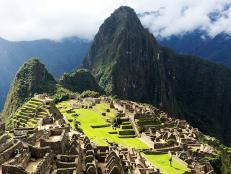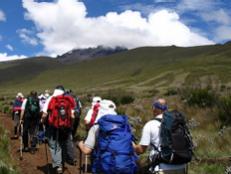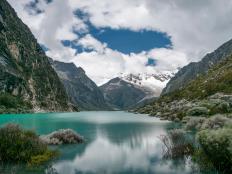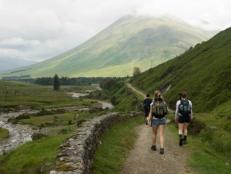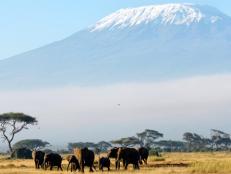The Trek to Vinicunca: How to Hike Peru's Rainbow Mountain Like a Pro
Explore unique geology, culture and adventure along this epic hike into the Peruvian Andes.

Related To:
lessRelated To:
Rainbow Mountain
Vinicunca, also known as Rainbow Mountain, is part of Peru's Ausangate mountains in the Andes range. Also called the Mountain of Seven Colors (and also spelled Vinicuna or Vinincunca), its hues of yellow, blue, green and red striations were formed by the area’s minerals that include iron, sulfur and copper. Volcanic and rift activity pushed these layers up and sideways, and glaciers and weathering have sculpted them. Sacred since pre-Inca times and still revered by the Quechua people who live throughout this region, pilgrimages have long been made to Vinicunca, including during the Snow Star Festival that takes place annually 60 days after Easter (Corpus Christi).
A World-Class Hike
Vinicunca is located in southern Peru some 85 rugged miles southeast of Cusco. Until just a few years ago it was reached only after a six-day hike, but tourism has funded a road that now allows hikers to take a 3-hour bus ride from Cusco, followed by a 3-hour hike to Rainbow Mountain’s overlook, making it possible to see Rainbow Mountain in one long day. Weather permitting, about 600 hikers from all over the world make this trek daily.
Take a Tour
Several tour companies operate out of Cusco with pricing starting at about $30 (about 100 Peruvian Soles, tip not included). Tour arrangements can be made online before arrival in Cusco, or once you’ve arrived in town - booking in town is often less expensive. Once in Cusco, you can shop around for tours. Around the historic Plaza de Armas there are several tourism operator storefronts, and tour operators on the plaza with flip boards detail pricing and what hikers can expect. Vertigo Travel Peru charges $30 for the one-day group tour that includes a guide, driver and transportation, and a breakfast and lunch buffet. Rainbow Mountain Cusco charges $40, and also offers private and multi-day camping itineraries in the area.
What to Expect
One-day group tours begin with an early morning bus or passenger van pick-up at your hotel or near the Plaza de Armas, typically between 4 and 5 a.m. Groups are typically 15 people. The 3-hour drive takes hikers to either the trailhead reached via Hanchipacha (14,320 feet) or Quesiuno (14,189 feet). If included in your tour, breakfast is served, and at around 8 a.m., hikers begin the 3.7-mile trek to the Vinicunca overlook, averaging about three hours for the hike. The gain in elevation to the overlook at about 16,500 feet is more than 2,000 feet of steady climbing, and guides often have oxygen for those who need to catch their breath. Horses with handlers are available at the trailheads for those who’d prefer to ride, costing about $20 (70 Peruvian Soles, cash only). The horses are rented out by local residents, and guides can help arrange the transaction. Many tour companies have a communal horse on site that hikers can take turns riding. Upon arriving at Rainbow Mountain, hikers typically have an hour and a half before starting back down the trail, which going downhill, takes an average of two hours. Back at the trailhead town, lunch is served before the 3-hour drive back to Cusco. Most hikers are back at their hotels at about 7 p.m.
Beware of Color Variation
Hikers are sometimes surprised that Rainbow Mountain isn’t as strikingly colorful as it appears in some photographs. Weather, cloud cover and time of day greatly influence the intensity of the colors, and often times, the color saturation has been digitally increased in photos. Color intensity aside, the view is still impressive, and hiking through the Andean landscape meeting locals along the way makes this trek one of the most special in the world.
When to Go
October through April is Peru’s rainy season (spring and summer), though the temperatures and weather can be beautiful. May through September, Peru’s fall and winter, is typically dry. Always plan for rain and cold any time of year in Peru’s mountains where the weather is difficult to predict and can change suddenly. When booking a tour, it’s advisable to be flexible in case you need to go the next day due to weather. Tours also recommend that hikers arrive in Cusco a day or two before their tour in order to acclimate to the elevation.
What to Know About Currency
Along the route, local Quechuan artists sell chullos, the iconic Peruvian hats with earflaps made from alpaca or llama wool, sweaters and souvenirs. Many items cost in the neighborhood of $3 (10 Peruvian Soles). Peruvian currency is based on the Sol, and its symbol is PEN (Peruvian Nuevo Sol). It's a good idea to have local cash currency in change for making such purchases, though US dollars are often accepted,but you may wind up paying more. Cusco has ATMs, and transaction fees typically cost 18 Soles (about $5). Three hundred Soles, an option on ATMs, equals about $90. It is polite to make a purchase before asking to photograph a vendor or to offer to pay a 1 Sol coin to take a photo.
What to Pack
The weather at Vinicunca is notoriously capricious, with frigid temperatures in the mornings and searing sun in the afternoon. Hikers should wear layers that can be removed or added depending on the temperatures. Even in cold weather a sunhat, sunglasses and even sunscreen are a necessity. At these high altitudes, ultraviolet rays are intense, even on cloudy days. Hikers should be well-hydrated before starting and carry a recommended two liters of water for the trip (restrooms are available along the trail). A rain shell or poncho is recommended for cold rain showers that can sweep in without warning, sometimes turning into snow showers even in the summer months. Hiking poles are helpful and take the strain off of knees. Limit alcohol consumption the day before your hike, and make sure to get a good night’s rest. Be sure to have plenty of camera memory and batteries, and a properly fitted backpack to carry all of your gear.
Leave Room for Souvenirs
Peruvian arts, such as this Quechuan weaving done on a backstrap loom, are world renowned and offered for sale in Cusco and along the journey to Rainbow Mountain. Several types of materials are used in Peruvian weavings, the most expensive being the wool of the vicuna, then baby alpaca, alpaca, llama and sheep. Alpacas and llamas raised for their wool are seen grazing all along the hike to Rainbow Mountain. Agriculture employs 30 percent of Peru's population and is an important part of its culture and traditions.
Explore Cusco
Take at least a day before or after your hike to Rainbow Mountain to explore the ancient city of Cusco, capital of the Inca Empire and today a UNESCO World Heritage Site. Impressive Inca and Pre-Inca sites such as Sacsayhuaman are open to the public. The Spanish cathedral Iglesia de la Compania de Jesus, built in Renaissance style beginning in 1576, is filled with art that combines indigenous and Catholic imagery, called the Cuzco School tradition. The Plaza de Armas is a great place to people watch and learn all about Peru’s national drink at the Museo del Pisco. The Boleto Turistico del Cusco is a master ticket that for 130 Soles (about $40) lets you visit 14 cultural sites in the Cusco area. It can be purchased at any of the sites to which it allows entry (cash Soles only). The tour company Raices Peru offers Cusco and area tours to the Sacred Valley.
Peru: A Country Made for Adventure
Trekking to Vinicunca is often part of a larger Cusco/Sacred Valley itinerary that includes Machu Picchu, Ollantaytambo, the Maras Salt Ponds and other pre-Columbian sites that make Peru a prime destination for travelers worldwide. Machu Picchu is only reached via hiking the Inca Trail or by rail, either Peru Rail or Inca Rail. For those hiking to Machu Picchu, the trek to Rainbow Mountain can serve as a good warm up to the multi-day hike.
